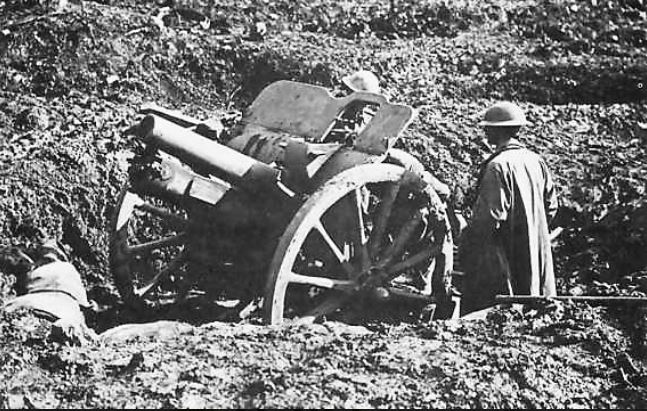Difference between revisions of "23rd Field Artillery (Howitzer) Brigade"
From Our Contribution
m (Linton moved page 23rd Howiter Brigade to 23rd Field Artillery (Howitzer) Brigade without leaving a redirect) |
|||
| Line 1: | Line 1: | ||
{{Infobox | {{Infobox | ||
| − | | name = 23rd Howiter Brigade | + | | name = 23rd Field Artillery (Howiter) Brigade |
| title = | | title = | ||
| above = | | above = | ||
| subheader = | | subheader = | ||
| − | | image = [[File:]] | + | | image = [[File:23rd_Howitzer.jpg]] |
| − | | caption = | + | | caption = 4.5 inch (12cm) Howitzer |
| − | | image2 = | + | | image2 = [[File:23rd_How.jpg]] |
| − | | caption2 = | + | | caption2 = Shoulder patch |
}} | }} | ||
| Line 14: | Line 14: | ||
==Brief History== | ==Brief History== | ||
| + | Howitzer Brigades were added to the establishment of Divisional Artillery for the Western Front. 18 pounder field guns did not have teh power to defeat well prepared defensive positions such as German blockhouses and concrete dugouts. A Howitzer Battery was originally raised for each Field Artillery Brigade but concentration was the name of the game and it was realised more were required, so the Howitzer Brigades comprising 12 x 4.5 inch howitzers were raised; 21 through 25, the second digit indicating the Division to which it was assigned. Thus the 23rd Howitzer Brigade acted in support of the 3rd Division. | ||
| + | A howitzer is a relatively short barreled gun that fires a comparatively heavy shell at moderate velocity on a high trajectory causing the shells to fall steeply or 'lob' into the enemy positions. When the shell is fitted with a delay fuse, the projectile will detonate sub-surface which is the desired effect to destroy trenches dugouts and the like. | ||
| + | On arrival in France, the artillery was re-organised with each field artillery brigade having 12 x 18 pounders and 4 x 4.5 inch howitzers. There was initially a lack of howitzers available to meet the establishment. In March 1916 a fourth battery of four 18 pounder field guns was added. At the same time a Howitzer Brigade was raised for each division with 12 x 4.5 inch howitzers each. The Howitzer Brigades were short lived though. Because of supply constraints in respect of the guns, the Howitzer Brigades were broken up and the batteries distributed among the Field Artillery Brigades of each Division in early 1917, as had been originally intended. | ||
| − | |||
| + | One member of this unit was killed in action and two others died of illness in England. | ||
| + | |||
| + | |||
| + | ===Unit Personnel=== | ||
| + | * [[James Candish]] 18 May - 25 Oct 1916 | ||
| Line 32: | Line 39: | ||
[[Category:AIF Units]] | [[Category:AIF Units]] | ||
| − | |||
| − | |||
Revision as of 22:24, 24 March 2021
 4.5 inch (12cm) Howitzer | |
|
File:23rd How.jpg Shoulder patch | |
Brief History
Howitzer Brigades were added to the establishment of Divisional Artillery for the Western Front. 18 pounder field guns did not have teh power to defeat well prepared defensive positions such as German blockhouses and concrete dugouts. A Howitzer Battery was originally raised for each Field Artillery Brigade but concentration was the name of the game and it was realised more were required, so the Howitzer Brigades comprising 12 x 4.5 inch howitzers were raised; 21 through 25, the second digit indicating the Division to which it was assigned. Thus the 23rd Howitzer Brigade acted in support of the 3rd Division.
A howitzer is a relatively short barreled gun that fires a comparatively heavy shell at moderate velocity on a high trajectory causing the shells to fall steeply or 'lob' into the enemy positions. When the shell is fitted with a delay fuse, the projectile will detonate sub-surface which is the desired effect to destroy trenches dugouts and the like.
On arrival in France, the artillery was re-organised with each field artillery brigade having 12 x 18 pounders and 4 x 4.5 inch howitzers. There was initially a lack of howitzers available to meet the establishment. In March 1916 a fourth battery of four 18 pounder field guns was added. At the same time a Howitzer Brigade was raised for each division with 12 x 4.5 inch howitzers each. The Howitzer Brigades were short lived though. Because of supply constraints in respect of the guns, the Howitzer Brigades were broken up and the batteries distributed among the Field Artillery Brigades of each Division in early 1917, as had been originally intended.
One member of this unit was killed in action and two others died of illness in England.
Unit Personnel
- James Candish 18 May - 25 Oct 1916
Individual Honours
Notes